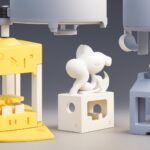The Role of 3D Printing in Education
### **The Role of 3D Printing in Education**
**3D printing** is revolutionizing the way students learn by providing hands-on experiences in design, engineering, and innovation. Across **schools**, **universities**, and specialized **educational programs**, this technology is enabling students to visualize and create complex models, transforming abstract concepts into tangible objects. The integration of **3D printing in education** is helping to bridge the gap between theoretical knowledge and practical application, fostering creativity and critical thinking.
#### **How 3D Printing is Used in Schools and Universities**
1. **Enhancing STEM Education**: **3D printing** is a key tool in teaching science, technology, engineering, and mathematics (STEM). By incorporating **teaching with 3D printers**, educators allow students to design and produce prototypes, explore mathematical models, and study engineering principles in a more interactive way. For example, students can design and print 3D models of molecules, historical artifacts, or engineering prototypes, improving their understanding of complex subjects.
2. **Fostering Creativity and Innovation**: In design and art classes, **3D printing** encourages students to think outside the box. They can conceptualize ideas and bring them to life through digital modeling. This hands-on approach inspires students to engage more deeply with the material, fostering a sense of innovation and creative problem-solving.
3. **Practical Applications for Engineering Students**: In universities, **3D printing for students** in engineering programs is particularly valuable. Students can prototype parts, test new designs, and learn advanced manufacturing techniques. This practical experience gives them a competitive edge when entering the workforce, as they are well-versed in the tools and processes used in modern engineering.
4. **Collaboration Across Disciplines**: **3D printing in education** promotes interdisciplinary collaboration. Students from different fields, such as engineering, art, biology, and architecture, can work together on projects, bringing diverse perspectives and skills to the table. This collaborative approach mirrors real-world problem-solving environments, where teams must work together to develop innovative solutions.
#### **The Benefits of 3D Printing in Education**
– **Hands-On Learning**: By creating physical models, students gain a deeper understanding of the subject matter, making learning more engaging and effective.
– **Cost-Effective Prototyping**: Instead of purchasing expensive models or equipment, schools can use **3D printers** to produce their own educational materials at a fraction of the cost.
– **Immediate Feedback**: Students can quickly print, test, and improve their designs, receiving immediate feedback on their work. This process reinforces the principles of iterative design and problem-solving.
– **Real-World Skills**: As **3D printing** becomes more widespread in various industries, students equipped with these skills will be better prepared for future careers in fields such as engineering, architecture, product design, and healthcare.
#### **Challenges and Future Outlook**
While the benefits of **3D printing in education** are numerous, challenges remain. Schools need access to printers, materials, and training for educators to integrate the technology effectively. However, as the cost of **3D printers** continues to decrease and their accessibility increases, the future of **3D printing** in educational settings looks promising. More institutions are adopting this technology, ensuring that the next generation of students is equipped with the skills needed for a rapidly evolving workforce.
#### **Conclusion**
**3D printing** is playing a transformative role in modern education, from elementary schools to universities. By incorporating **3D printing for students**, educators are creating more dynamic and interactive learning environments that emphasize creativity, problem-solving, and innovation. As this technology continues to evolve, its impact on teaching and learning will only deepen, preparing students for the challenges and opportunities of tomorrow.



